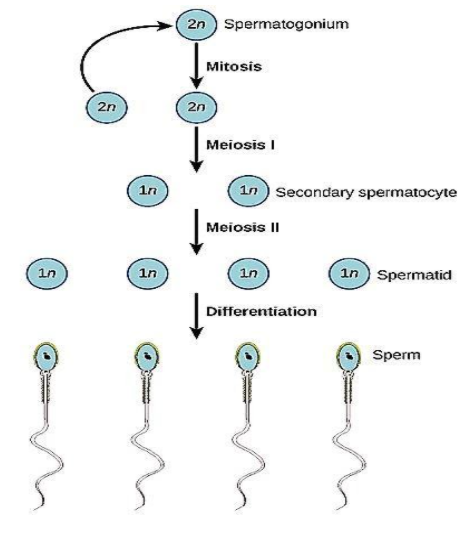
Indicate the correct sequence during spermatogenesis.
A. Spermatozoa $ \to $ spermatogonia $ \to $ spermatid $ \to $ spermatocyte.
B. Spermatogonia $ \to $ spermatocyte $ \to $ spermatid $ \to $ spermatozoa.
C. Spermatid $ \to $ spermatocyte $ \to $ spermatozoa $ \to $ spermatogonia.
D. Spermatocyte $ \to $ spermatozoa $ \to $ spermatid $ \to $ spermatogonia.
Answer
568.8k+ views
Hint: The word spermatogenesis has been derived from two words, the Greek word sperma which means ‘the seed or germ’, and the other word genesis which means ‘birth’ or ‘origin’ or ‘creation’. Hence, it is the process of the formation of mature sperm cells.
Complete answer:
Spermatogenesis is a form of gametogenesis that takes place in the seminiferous tubule of the male testis and is known to produce mature sperm cells known as spermatozoa from undifferentiated male germ cells. This process involves a series of stages:
Spermatocytogenesis is that stage in which through mitotic cell division, the spermatogonia give rise to primary spermatocytes. These primary spermatocytes (having ‘2n’ number of chromosomes) undergo meiosis I and produce secondary spermatocytes (having ‘n’ number of chromosomes).
Spermatidogenesis is the stage which involves the formation of spermatids (haploid sperm cells) from the secondary spermatocytes by the process of meiosis II.
Spermiogenesis is the stage during which the spermatids transform into spermatozoa (mature sperm cells) by the process of differentiation.
Stages of spermatogenesis.
Therefore, the sequence of spermatogenesis is-
Spermatogonia $ \to $ spermatocyte $ \to $ spermatid $ \to $ spermatozoa
Options (A), (C), and (D) do not represent the correct sequence of spermatogenesis. Therefore, these options are incorrect.

Hence, the correct option is (B).
Note: The spermatogenesis process starts with the diploid spermatogonium. This spermatogonia is an undifferentiated stem cell that undergoes mitosis to produce primary spermatocytes. Each primary spermatocyte undergoes meiosis I to give rise to two haploid secondary spermatocytes. Each secondary spermatocyte undergoes meiosis II to give rise to four haploid spermatids (i.e., two spermatids from each secondary spermatocyte). These spermatids then develop into mature sperm cells called spermatozoa.
Complete answer:
Spermatogenesis is a form of gametogenesis that takes place in the seminiferous tubule of the male testis and is known to produce mature sperm cells known as spermatozoa from undifferentiated male germ cells. This process involves a series of stages:
Spermatocytogenesis is that stage in which through mitotic cell division, the spermatogonia give rise to primary spermatocytes. These primary spermatocytes (having ‘2n’ number of chromosomes) undergo meiosis I and produce secondary spermatocytes (having ‘n’ number of chromosomes).
Spermatidogenesis is the stage which involves the formation of spermatids (haploid sperm cells) from the secondary spermatocytes by the process of meiosis II.
Spermiogenesis is the stage during which the spermatids transform into spermatozoa (mature sperm cells) by the process of differentiation.
Stages of spermatogenesis.
Therefore, the sequence of spermatogenesis is-
Spermatogonia $ \to $ spermatocyte $ \to $ spermatid $ \to $ spermatozoa
Options (A), (C), and (D) do not represent the correct sequence of spermatogenesis. Therefore, these options are incorrect.

Hence, the correct option is (B).
Note: The spermatogenesis process starts with the diploid spermatogonium. This spermatogonia is an undifferentiated stem cell that undergoes mitosis to produce primary spermatocytes. Each primary spermatocyte undergoes meiosis I to give rise to two haploid secondary spermatocytes. Each secondary spermatocyte undergoes meiosis II to give rise to four haploid spermatids (i.e., two spermatids from each secondary spermatocyte). These spermatids then develop into mature sperm cells called spermatozoa.
Recently Updated Pages
A man running at a speed 5 ms is viewed in the side class 12 physics CBSE

State and explain Hardy Weinbergs Principle class 12 biology CBSE

Which of the following statements is wrong a Amnion class 12 biology CBSE

Two Planoconcave lenses 1 and 2 of glass of refractive class 12 physics CBSE

The compound 2 methyl 2 butene on reaction with NaIO4 class 12 chemistry CBSE

Bacterial cell wall is made up of A Cellulose B Hemicellulose class 12 biology CBSE

Trending doubts
What are the major means of transport Explain each class 12 social science CBSE

Which are the Top 10 Largest Countries of the World?

Draw a labelled sketch of the human eye class 12 physics CBSE

Explain sex determination in humans with line diag class 12 biology CBSE

The pH of the pancreatic juice is A 64 B 86 C 120 D class 12 biology CBSE

Give 10 examples of unisexual and bisexual flowers




